Analysis of HRM Practices in Health and Social Care: A Report
VerifiedAdded on 2021/02/19
|13
|4243
|17
Report
AI Summary
This report provides a comprehensive analysis of Human Resource Management (HRM) practices within the health and social care sector, focusing on the "Happiness All Around" healthcare organization. It begins by examining crucial factors in candidate recruitment, including skills, experience, and legal considerations such as the Equality Act 2010. The report then delves into different selection approaches, comparing interviews and psychometric tests, and highlights their advantages and disadvantages. Furthermore, it explores team dynamics using the Tuckman and Belbin models, emphasizing the importance of effective teamwork in delivering quality care. The report also covers leadership theories relevant to health and social care, methods for managing working relationships, and concludes with a self-evaluation of the author's development influenced by management approaches.

Managing Human
Resources in Health and
Social Care
Resources in Health and
Social Care
Paraphrase This Document
Need a fresh take? Get an instant paraphrase of this document with our AI Paraphraser

Table of Contents
INTRODUCTION 1
TASK 1 1
1.1 Factors to be considered while planning recruitment of candidates.....................................1
1.2 Relevant legislative polices of home country influencing selection, recruitment.................2
1.3 Different approaches used to ensure best selection of candidate at work place...................2
TASK 2 4
2.1 Theories showing interaction of individuals in group in relation to types of teams.............4
2.2 Approaches used to develop effective team working...........................................................5
TASK 4 6
4.1 Theories of leadership implemented to health and social care..............................................6
4.2 Analyse how working relationships can manage..................................................................7
4.3 Evaluation of own development influenced by management approaches considering own
experience...................................................................................................................................7
TASK 3 8
CONCLUSION 8
REFERENCES 9
INTRODUCTION 1
TASK 1 1
1.1 Factors to be considered while planning recruitment of candidates.....................................1
1.2 Relevant legislative polices of home country influencing selection, recruitment.................2
1.3 Different approaches used to ensure best selection of candidate at work place...................2
TASK 2 4
2.1 Theories showing interaction of individuals in group in relation to types of teams.............4
2.2 Approaches used to develop effective team working...........................................................5
TASK 4 6
4.1 Theories of leadership implemented to health and social care..............................................6
4.2 Analyse how working relationships can manage..................................................................7
4.3 Evaluation of own development influenced by management approaches considering own
experience...................................................................................................................................7
TASK 3 8
CONCLUSION 8
REFERENCES 9
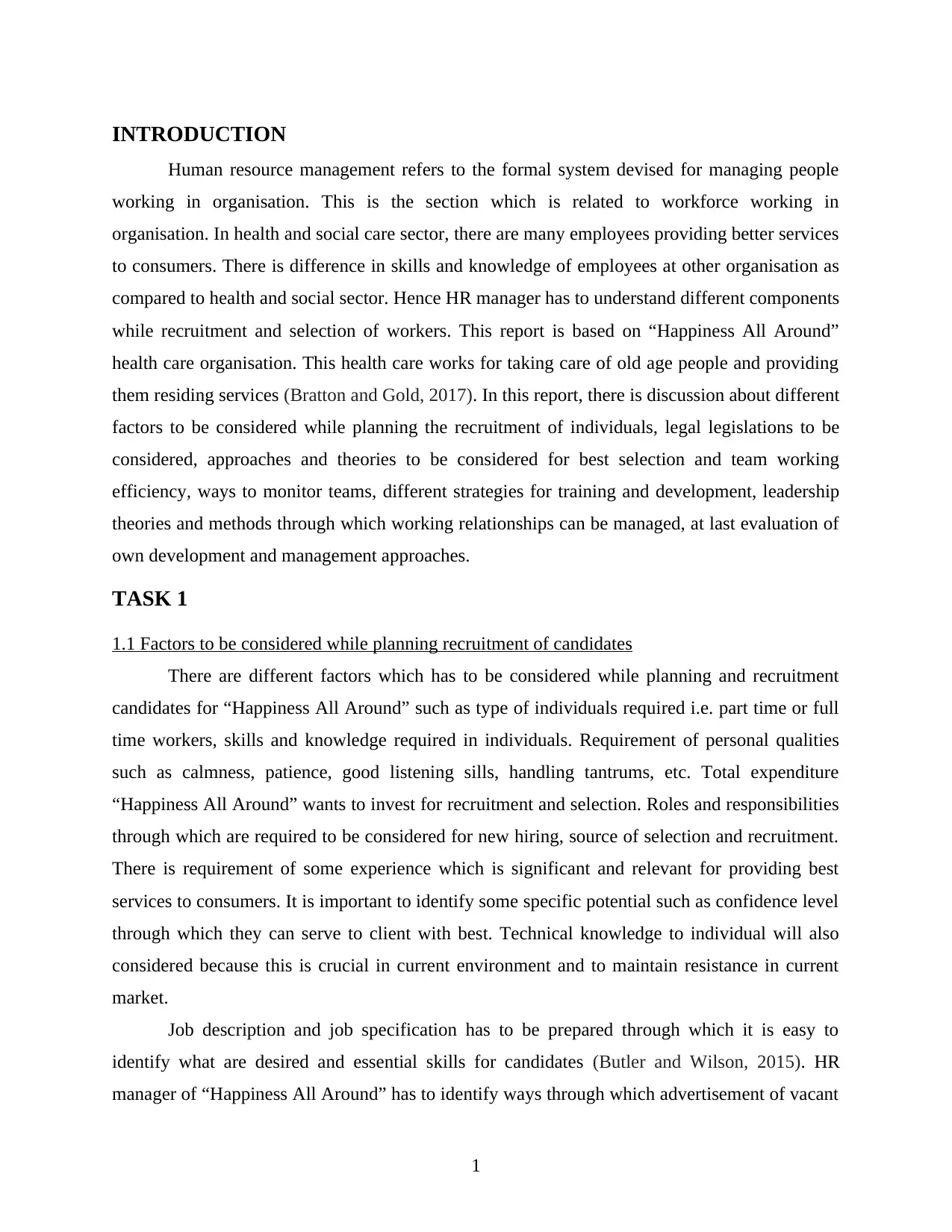
INTRODUCTION
Human resource management refers to the formal system devised for managing people
working in organisation. This is the section which is related to workforce working in
organisation. In health and social care sector, there are many employees providing better services
to consumers. There is difference in skills and knowledge of employees at other organisation as
compared to health and social sector. Hence HR manager has to understand different components
while recruitment and selection of workers. This report is based on “Happiness All Around”
health care organisation. This health care works for taking care of old age people and providing
them residing services (Bratton and Gold, 2017). In this report, there is discussion about different
factors to be considered while planning the recruitment of individuals, legal legislations to be
considered, approaches and theories to be considered for best selection and team working
efficiency, ways to monitor teams, different strategies for training and development, leadership
theories and methods through which working relationships can be managed, at last evaluation of
own development and management approaches.
TASK 1
1.1 Factors to be considered while planning recruitment of candidates
There are different factors which has to be considered while planning and recruitment
candidates for “Happiness All Around” such as type of individuals required i.e. part time or full
time workers, skills and knowledge required in individuals. Requirement of personal qualities
such as calmness, patience, good listening sills, handling tantrums, etc. Total expenditure
“Happiness All Around” wants to invest for recruitment and selection. Roles and responsibilities
through which are required to be considered for new hiring, source of selection and recruitment.
There is requirement of some experience which is significant and relevant for providing best
services to consumers. It is important to identify some specific potential such as confidence level
through which they can serve to client with best. Technical knowledge to individual will also
considered because this is crucial in current environment and to maintain resistance in current
market.
Job description and job specification has to be prepared through which it is easy to
identify what are desired and essential skills for candidates (Butler and Wilson, 2015). HR
manager of “Happiness All Around” has to identify ways through which advertisement of vacant
1
Human resource management refers to the formal system devised for managing people
working in organisation. This is the section which is related to workforce working in
organisation. In health and social care sector, there are many employees providing better services
to consumers. There is difference in skills and knowledge of employees at other organisation as
compared to health and social sector. Hence HR manager has to understand different components
while recruitment and selection of workers. This report is based on “Happiness All Around”
health care organisation. This health care works for taking care of old age people and providing
them residing services (Bratton and Gold, 2017). In this report, there is discussion about different
factors to be considered while planning the recruitment of individuals, legal legislations to be
considered, approaches and theories to be considered for best selection and team working
efficiency, ways to monitor teams, different strategies for training and development, leadership
theories and methods through which working relationships can be managed, at last evaluation of
own development and management approaches.
TASK 1
1.1 Factors to be considered while planning recruitment of candidates
There are different factors which has to be considered while planning and recruitment
candidates for “Happiness All Around” such as type of individuals required i.e. part time or full
time workers, skills and knowledge required in individuals. Requirement of personal qualities
such as calmness, patience, good listening sills, handling tantrums, etc. Total expenditure
“Happiness All Around” wants to invest for recruitment and selection. Roles and responsibilities
through which are required to be considered for new hiring, source of selection and recruitment.
There is requirement of some experience which is significant and relevant for providing best
services to consumers. It is important to identify some specific potential such as confidence level
through which they can serve to client with best. Technical knowledge to individual will also
considered because this is crucial in current environment and to maintain resistance in current
market.
Job description and job specification has to be prepared through which it is easy to
identify what are desired and essential skills for candidates (Butler and Wilson, 2015). HR
manager of “Happiness All Around” has to identify ways through which advertisement of vacant
1
⊘ This is a preview!⊘
Do you want full access?
Subscribe today to unlock all pages.

Trusted by 1+ million students worldwide
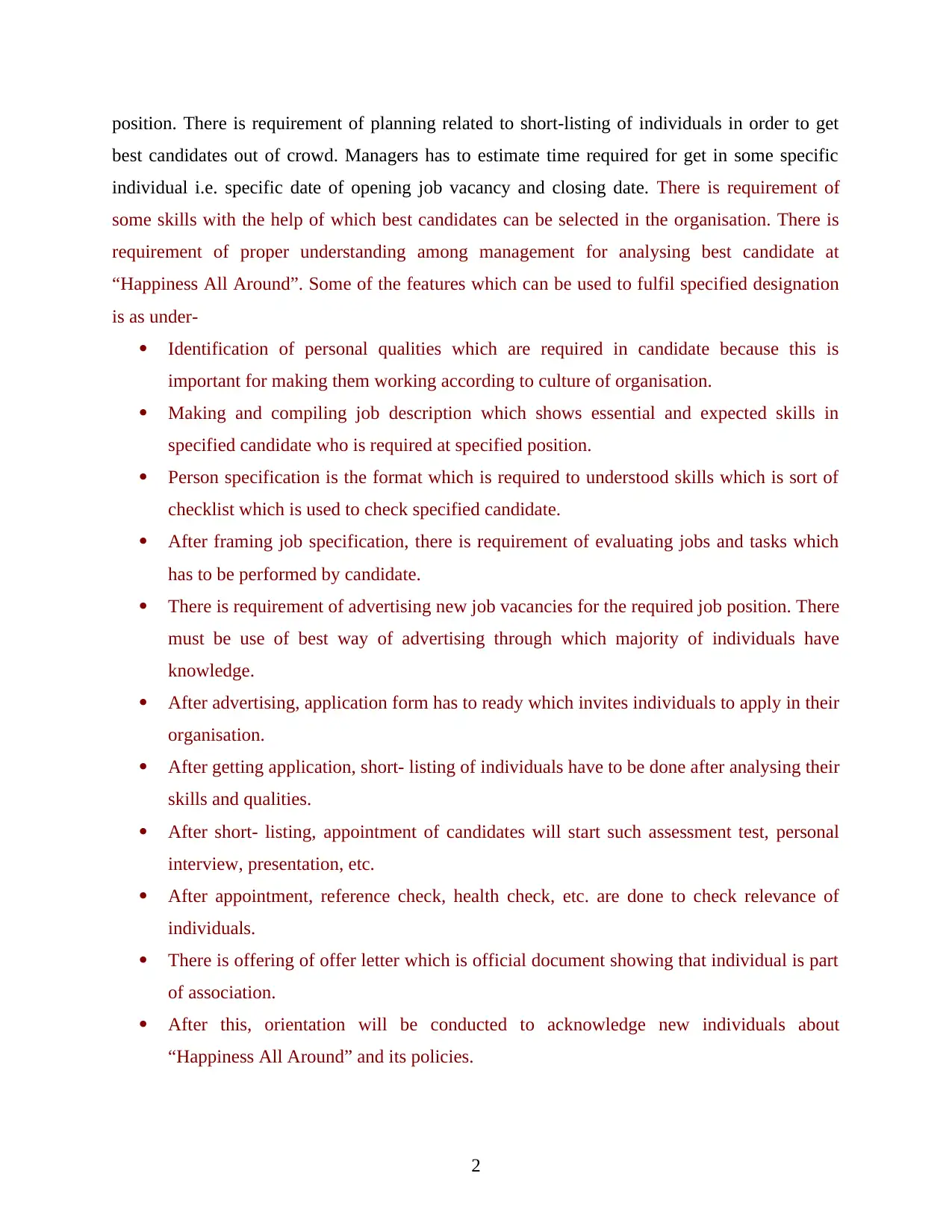
position. There is requirement of planning related to short-listing of individuals in order to get
best candidates out of crowd. Managers has to estimate time required for get in some specific
individual i.e. specific date of opening job vacancy and closing date. There is requirement of
some skills with the help of which best candidates can be selected in the organisation. There is
requirement of proper understanding among management for analysing best candidate at
“Happiness All Around”. Some of the features which can be used to fulfil specified designation
is as under-
Identification of personal qualities which are required in candidate because this is
important for making them working according to culture of organisation.
Making and compiling job description which shows essential and expected skills in
specified candidate who is required at specified position.
Person specification is the format which is required to understood skills which is sort of
checklist which is used to check specified candidate.
After framing job specification, there is requirement of evaluating jobs and tasks which
has to be performed by candidate.
There is requirement of advertising new job vacancies for the required job position. There
must be use of best way of advertising through which majority of individuals have
knowledge.
After advertising, application form has to ready which invites individuals to apply in their
organisation.
After getting application, short- listing of individuals have to be done after analysing their
skills and qualities.
After short- listing, appointment of candidates will start such assessment test, personal
interview, presentation, etc.
After appointment, reference check, health check, etc. are done to check relevance of
individuals.
There is offering of offer letter which is official document showing that individual is part
of association.
After this, orientation will be conducted to acknowledge new individuals about
“Happiness All Around” and its policies.
2
best candidates out of crowd. Managers has to estimate time required for get in some specific
individual i.e. specific date of opening job vacancy and closing date. There is requirement of
some skills with the help of which best candidates can be selected in the organisation. There is
requirement of proper understanding among management for analysing best candidate at
“Happiness All Around”. Some of the features which can be used to fulfil specified designation
is as under-
Identification of personal qualities which are required in candidate because this is
important for making them working according to culture of organisation.
Making and compiling job description which shows essential and expected skills in
specified candidate who is required at specified position.
Person specification is the format which is required to understood skills which is sort of
checklist which is used to check specified candidate.
After framing job specification, there is requirement of evaluating jobs and tasks which
has to be performed by candidate.
There is requirement of advertising new job vacancies for the required job position. There
must be use of best way of advertising through which majority of individuals have
knowledge.
After advertising, application form has to ready which invites individuals to apply in their
organisation.
After getting application, short- listing of individuals have to be done after analysing their
skills and qualities.
After short- listing, appointment of candidates will start such assessment test, personal
interview, presentation, etc.
After appointment, reference check, health check, etc. are done to check relevance of
individuals.
There is offering of offer letter which is official document showing that individual is part
of association.
After this, orientation will be conducted to acknowledge new individuals about
“Happiness All Around” and its policies.
2
Paraphrase This Document
Need a fresh take? Get an instant paraphrase of this document with our AI Paraphraser
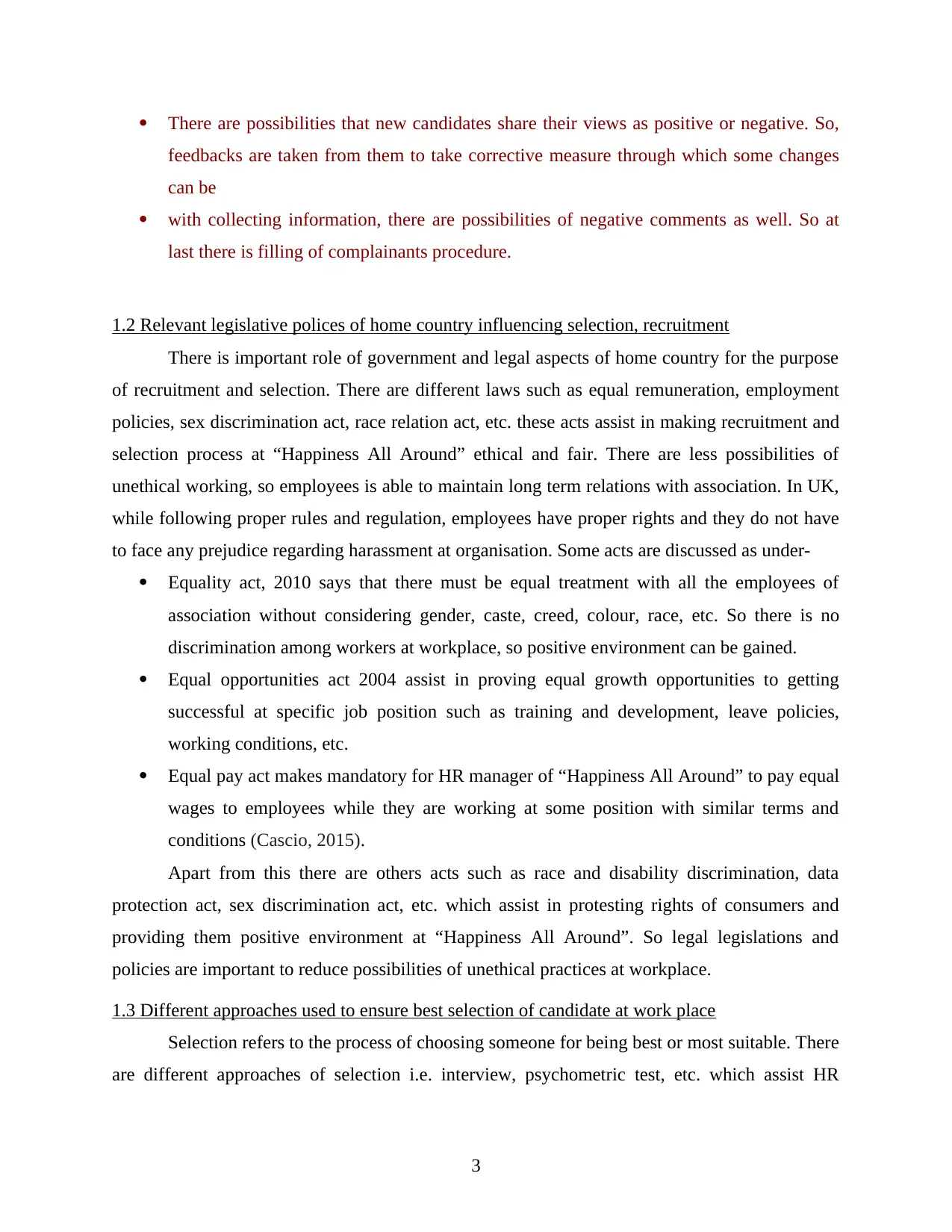
There are possibilities that new candidates share their views as positive or negative. So,
feedbacks are taken from them to take corrective measure through which some changes
can be
with collecting information, there are possibilities of negative comments as well. So at
last there is filling of complainants procedure.
1.2 Relevant legislative polices of home country influencing selection, recruitment
There is important role of government and legal aspects of home country for the purpose
of recruitment and selection. There are different laws such as equal remuneration, employment
policies, sex discrimination act, race relation act, etc. these acts assist in making recruitment and
selection process at “Happiness All Around” ethical and fair. There are less possibilities of
unethical working, so employees is able to maintain long term relations with association. In UK,
while following proper rules and regulation, employees have proper rights and they do not have
to face any prejudice regarding harassment at organisation. Some acts are discussed as under-
Equality act, 2010 says that there must be equal treatment with all the employees of
association without considering gender, caste, creed, colour, race, etc. So there is no
discrimination among workers at workplace, so positive environment can be gained.
Equal opportunities act 2004 assist in proving equal growth opportunities to getting
successful at specific job position such as training and development, leave policies,
working conditions, etc.
Equal pay act makes mandatory for HR manager of “Happiness All Around” to pay equal
wages to employees while they are working at some position with similar terms and
conditions (Cascio, 2015).
Apart from this there are others acts such as race and disability discrimination, data
protection act, sex discrimination act, etc. which assist in protesting rights of consumers and
providing them positive environment at “Happiness All Around”. So legal legislations and
policies are important to reduce possibilities of unethical practices at workplace.
1.3 Different approaches used to ensure best selection of candidate at work place
Selection refers to the process of choosing someone for being best or most suitable. There
are different approaches of selection i.e. interview, psychometric test, etc. which assist HR
3
feedbacks are taken from them to take corrective measure through which some changes
can be
with collecting information, there are possibilities of negative comments as well. So at
last there is filling of complainants procedure.
1.2 Relevant legislative polices of home country influencing selection, recruitment
There is important role of government and legal aspects of home country for the purpose
of recruitment and selection. There are different laws such as equal remuneration, employment
policies, sex discrimination act, race relation act, etc. these acts assist in making recruitment and
selection process at “Happiness All Around” ethical and fair. There are less possibilities of
unethical working, so employees is able to maintain long term relations with association. In UK,
while following proper rules and regulation, employees have proper rights and they do not have
to face any prejudice regarding harassment at organisation. Some acts are discussed as under-
Equality act, 2010 says that there must be equal treatment with all the employees of
association without considering gender, caste, creed, colour, race, etc. So there is no
discrimination among workers at workplace, so positive environment can be gained.
Equal opportunities act 2004 assist in proving equal growth opportunities to getting
successful at specific job position such as training and development, leave policies,
working conditions, etc.
Equal pay act makes mandatory for HR manager of “Happiness All Around” to pay equal
wages to employees while they are working at some position with similar terms and
conditions (Cascio, 2015).
Apart from this there are others acts such as race and disability discrimination, data
protection act, sex discrimination act, etc. which assist in protesting rights of consumers and
providing them positive environment at “Happiness All Around”. So legal legislations and
policies are important to reduce possibilities of unethical practices at workplace.
1.3 Different approaches used to ensure best selection of candidate at work place
Selection refers to the process of choosing someone for being best or most suitable. There
are different approaches of selection i.e. interview, psychometric test, etc. which assist HR
3
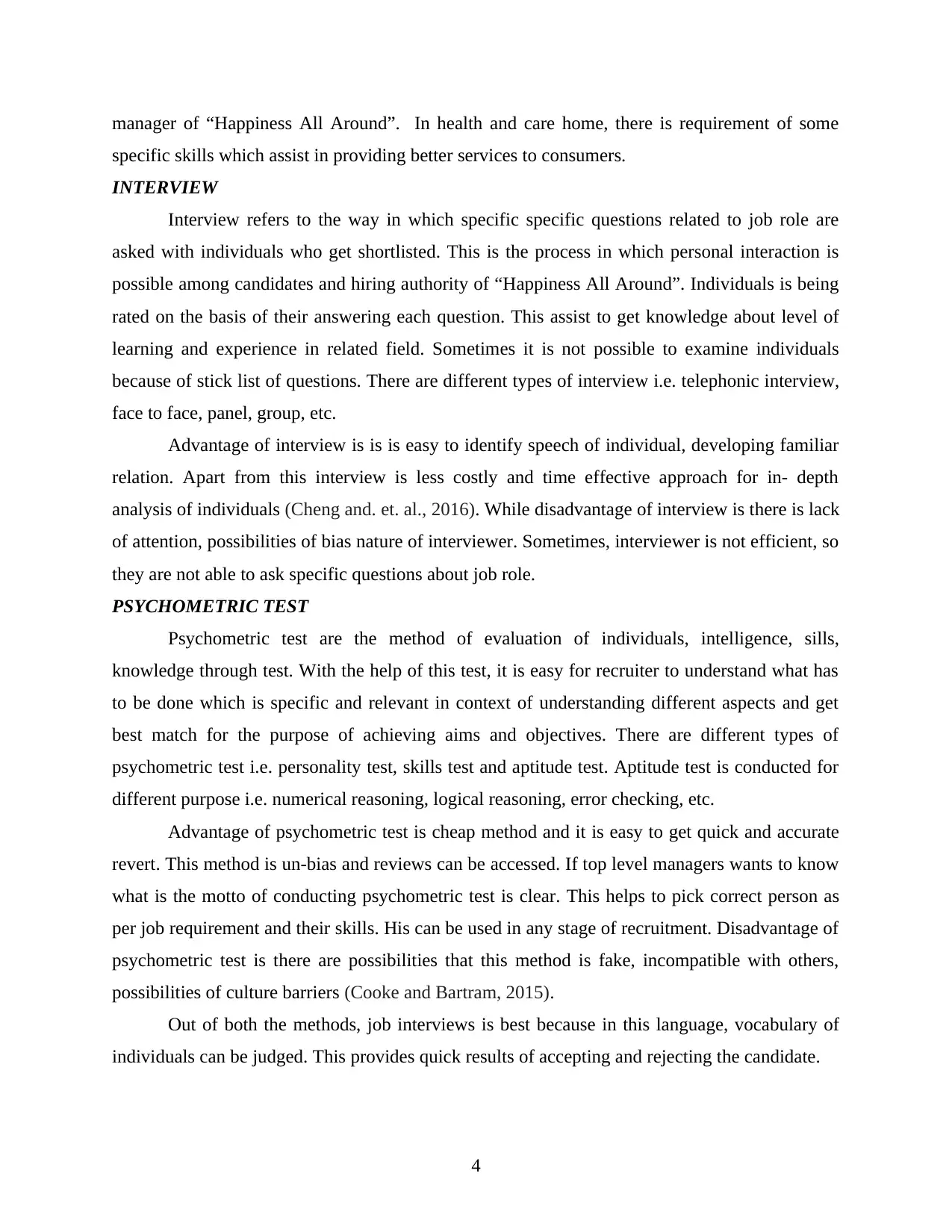
manager of “Happiness All Around”. In health and care home, there is requirement of some
specific skills which assist in providing better services to consumers.
INTERVIEW
Interview refers to the way in which specific specific questions related to job role are
asked with individuals who get shortlisted. This is the process in which personal interaction is
possible among candidates and hiring authority of “Happiness All Around”. Individuals is being
rated on the basis of their answering each question. This assist to get knowledge about level of
learning and experience in related field. Sometimes it is not possible to examine individuals
because of stick list of questions. There are different types of interview i.e. telephonic interview,
face to face, panel, group, etc.
Advantage of interview is is is easy to identify speech of individual, developing familiar
relation. Apart from this interview is less costly and time effective approach for in- depth
analysis of individuals (Cheng and. et. al., 2016). While disadvantage of interview is there is lack
of attention, possibilities of bias nature of interviewer. Sometimes, interviewer is not efficient, so
they are not able to ask specific questions about job role.
PSYCHOMETRIC TEST
Psychometric test are the method of evaluation of individuals, intelligence, sills,
knowledge through test. With the help of this test, it is easy for recruiter to understand what has
to be done which is specific and relevant in context of understanding different aspects and get
best match for the purpose of achieving aims and objectives. There are different types of
psychometric test i.e. personality test, skills test and aptitude test. Aptitude test is conducted for
different purpose i.e. numerical reasoning, logical reasoning, error checking, etc.
Advantage of psychometric test is cheap method and it is easy to get quick and accurate
revert. This method is un-bias and reviews can be accessed. If top level managers wants to know
what is the motto of conducting psychometric test is clear. This helps to pick correct person as
per job requirement and their skills. His can be used in any stage of recruitment. Disadvantage of
psychometric test is there are possibilities that this method is fake, incompatible with others,
possibilities of culture barriers (Cooke and Bartram, 2015).
Out of both the methods, job interviews is best because in this language, vocabulary of
individuals can be judged. This provides quick results of accepting and rejecting the candidate.
4
specific skills which assist in providing better services to consumers.
INTERVIEW
Interview refers to the way in which specific specific questions related to job role are
asked with individuals who get shortlisted. This is the process in which personal interaction is
possible among candidates and hiring authority of “Happiness All Around”. Individuals is being
rated on the basis of their answering each question. This assist to get knowledge about level of
learning and experience in related field. Sometimes it is not possible to examine individuals
because of stick list of questions. There are different types of interview i.e. telephonic interview,
face to face, panel, group, etc.
Advantage of interview is is is easy to identify speech of individual, developing familiar
relation. Apart from this interview is less costly and time effective approach for in- depth
analysis of individuals (Cheng and. et. al., 2016). While disadvantage of interview is there is lack
of attention, possibilities of bias nature of interviewer. Sometimes, interviewer is not efficient, so
they are not able to ask specific questions about job role.
PSYCHOMETRIC TEST
Psychometric test are the method of evaluation of individuals, intelligence, sills,
knowledge through test. With the help of this test, it is easy for recruiter to understand what has
to be done which is specific and relevant in context of understanding different aspects and get
best match for the purpose of achieving aims and objectives. There are different types of
psychometric test i.e. personality test, skills test and aptitude test. Aptitude test is conducted for
different purpose i.e. numerical reasoning, logical reasoning, error checking, etc.
Advantage of psychometric test is cheap method and it is easy to get quick and accurate
revert. This method is un-bias and reviews can be accessed. If top level managers wants to know
what is the motto of conducting psychometric test is clear. This helps to pick correct person as
per job requirement and their skills. His can be used in any stage of recruitment. Disadvantage of
psychometric test is there are possibilities that this method is fake, incompatible with others,
possibilities of culture barriers (Cooke and Bartram, 2015).
Out of both the methods, job interviews is best because in this language, vocabulary of
individuals can be judged. This provides quick results of accepting and rejecting the candidate.
4
⊘ This is a preview!⊘
Do you want full access?
Subscribe today to unlock all pages.

Trusted by 1+ million students worldwide
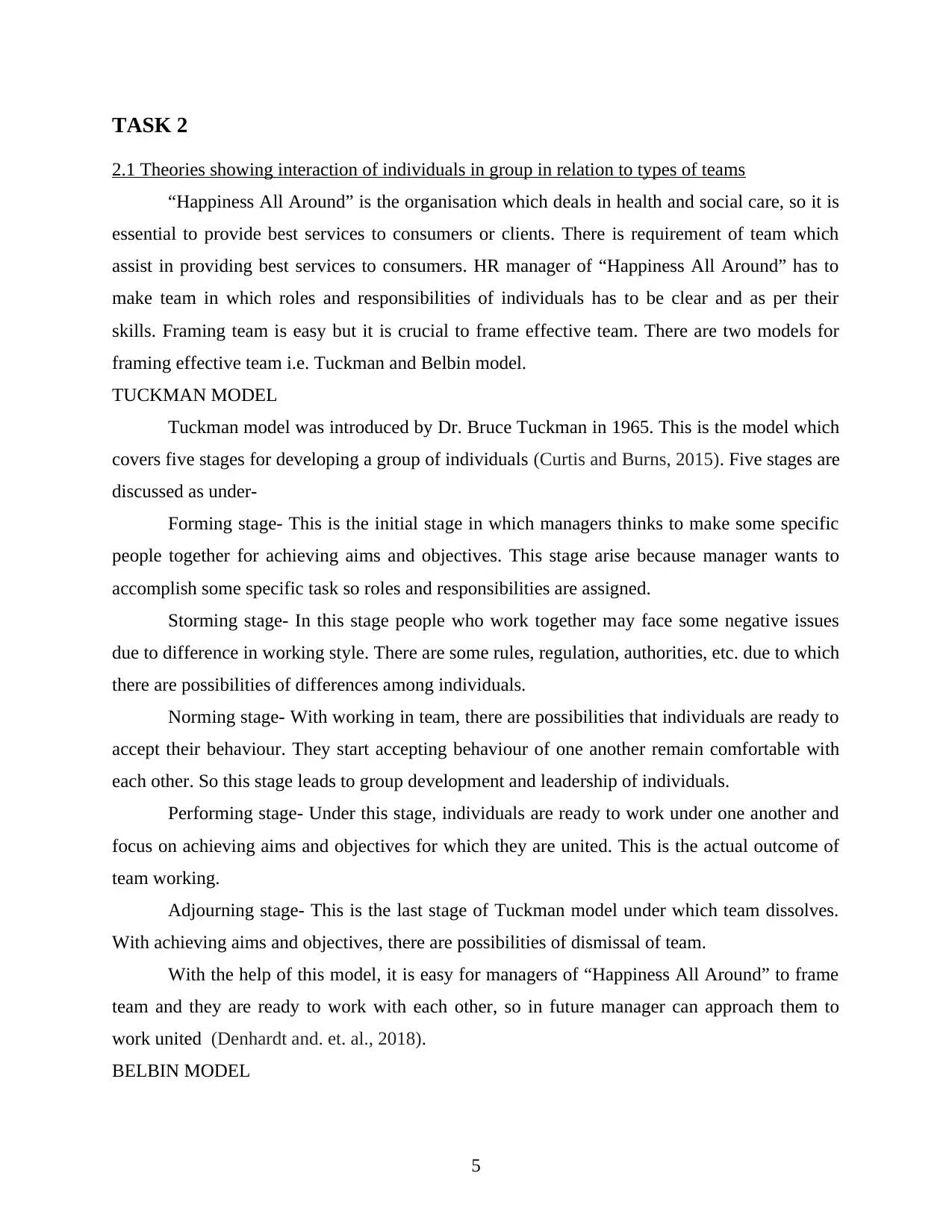
TASK 2
2.1 Theories showing interaction of individuals in group in relation to types of teams
“Happiness All Around” is the organisation which deals in health and social care, so it is
essential to provide best services to consumers or clients. There is requirement of team which
assist in providing best services to consumers. HR manager of “Happiness All Around” has to
make team in which roles and responsibilities of individuals has to be clear and as per their
skills. Framing team is easy but it is crucial to frame effective team. There are two models for
framing effective team i.e. Tuckman and Belbin model.
TUCKMAN MODEL
Tuckman model was introduced by Dr. Bruce Tuckman in 1965. This is the model which
covers five stages for developing a group of individuals (Curtis and Burns, 2015). Five stages are
discussed as under-
Forming stage- This is the initial stage in which managers thinks to make some specific
people together for achieving aims and objectives. This stage arise because manager wants to
accomplish some specific task so roles and responsibilities are assigned.
Storming stage- In this stage people who work together may face some negative issues
due to difference in working style. There are some rules, regulation, authorities, etc. due to which
there are possibilities of differences among individuals.
Norming stage- With working in team, there are possibilities that individuals are ready to
accept their behaviour. They start accepting behaviour of one another remain comfortable with
each other. So this stage leads to group development and leadership of individuals.
Performing stage- Under this stage, individuals are ready to work under one another and
focus on achieving aims and objectives for which they are united. This is the actual outcome of
team working.
Adjourning stage- This is the last stage of Tuckman model under which team dissolves.
With achieving aims and objectives, there are possibilities of dismissal of team.
With the help of this model, it is easy for managers of “Happiness All Around” to frame
team and they are ready to work with each other, so in future manager can approach them to
work united (Denhardt and. et. al., 2018).
BELBIN MODEL
5
2.1 Theories showing interaction of individuals in group in relation to types of teams
“Happiness All Around” is the organisation which deals in health and social care, so it is
essential to provide best services to consumers or clients. There is requirement of team which
assist in providing best services to consumers. HR manager of “Happiness All Around” has to
make team in which roles and responsibilities of individuals has to be clear and as per their
skills. Framing team is easy but it is crucial to frame effective team. There are two models for
framing effective team i.e. Tuckman and Belbin model.
TUCKMAN MODEL
Tuckman model was introduced by Dr. Bruce Tuckman in 1965. This is the model which
covers five stages for developing a group of individuals (Curtis and Burns, 2015). Five stages are
discussed as under-
Forming stage- This is the initial stage in which managers thinks to make some specific
people together for achieving aims and objectives. This stage arise because manager wants to
accomplish some specific task so roles and responsibilities are assigned.
Storming stage- In this stage people who work together may face some negative issues
due to difference in working style. There are some rules, regulation, authorities, etc. due to which
there are possibilities of differences among individuals.
Norming stage- With working in team, there are possibilities that individuals are ready to
accept their behaviour. They start accepting behaviour of one another remain comfortable with
each other. So this stage leads to group development and leadership of individuals.
Performing stage- Under this stage, individuals are ready to work under one another and
focus on achieving aims and objectives for which they are united. This is the actual outcome of
team working.
Adjourning stage- This is the last stage of Tuckman model under which team dissolves.
With achieving aims and objectives, there are possibilities of dismissal of team.
With the help of this model, it is easy for managers of “Happiness All Around” to frame
team and they are ready to work with each other, so in future manager can approach them to
work united (Denhardt and. et. al., 2018).
BELBIN MODEL
5
Paraphrase This Document
Need a fresh take? Get an instant paraphrase of this document with our AI Paraphraser
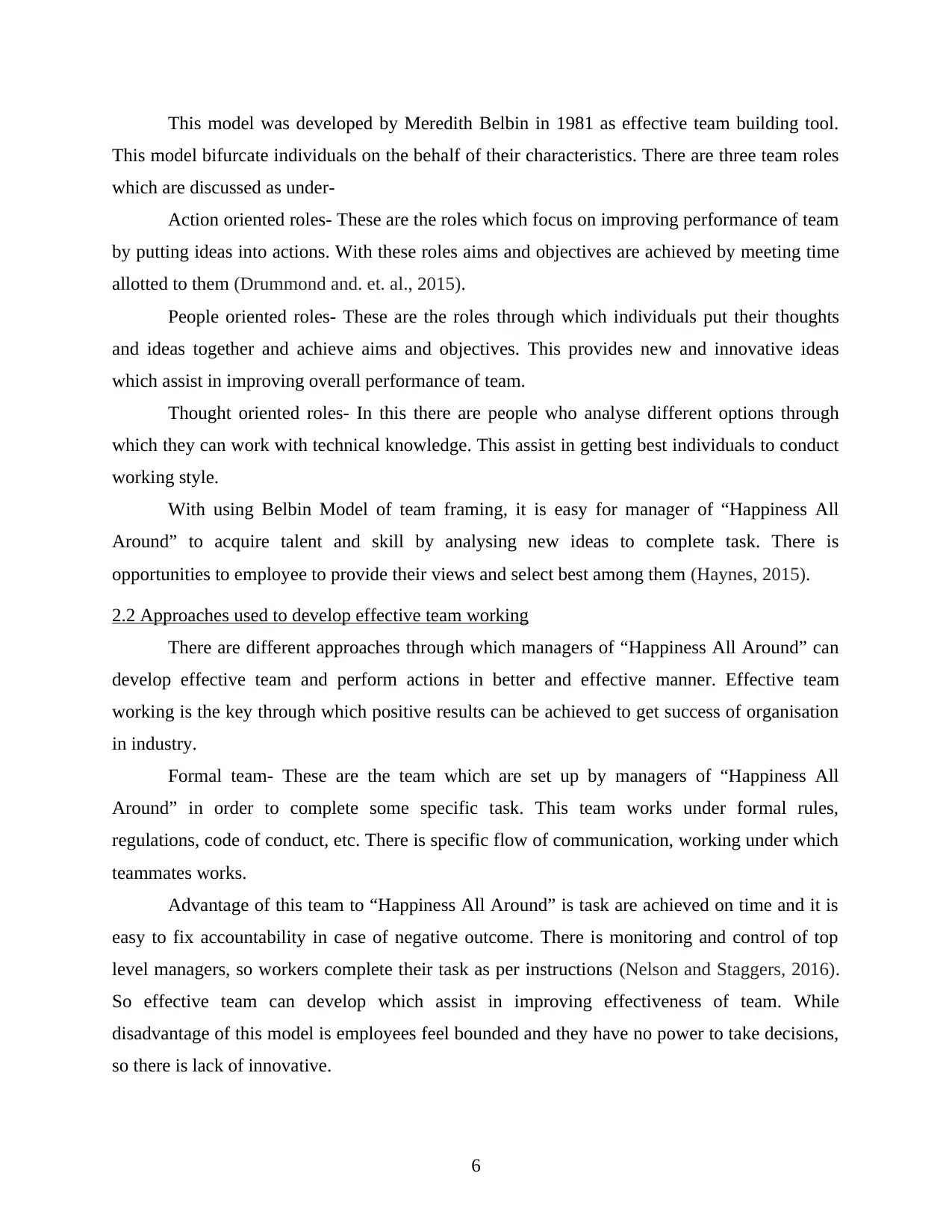
This model was developed by Meredith Belbin in 1981 as effective team building tool.
This model bifurcate individuals on the behalf of their characteristics. There are three team roles
which are discussed as under-
Action oriented roles- These are the roles which focus on improving performance of team
by putting ideas into actions. With these roles aims and objectives are achieved by meeting time
allotted to them (Drummond and. et. al., 2015).
People oriented roles- These are the roles through which individuals put their thoughts
and ideas together and achieve aims and objectives. This provides new and innovative ideas
which assist in improving overall performance of team.
Thought oriented roles- In this there are people who analyse different options through
which they can work with technical knowledge. This assist in getting best individuals to conduct
working style.
With using Belbin Model of team framing, it is easy for manager of “Happiness All
Around” to acquire talent and skill by analysing new ideas to complete task. There is
opportunities to employee to provide their views and select best among them (Haynes, 2015).
2.2 Approaches used to develop effective team working
There are different approaches through which managers of “Happiness All Around” can
develop effective team and perform actions in better and effective manner. Effective team
working is the key through which positive results can be achieved to get success of organisation
in industry.
Formal team- These are the team which are set up by managers of “Happiness All
Around” in order to complete some specific task. This team works under formal rules,
regulations, code of conduct, etc. There is specific flow of communication, working under which
teammates works.
Advantage of this team to “Happiness All Around” is task are achieved on time and it is
easy to fix accountability in case of negative outcome. There is monitoring and control of top
level managers, so workers complete their task as per instructions (Nelson and Staggers, 2016).
So effective team can develop which assist in improving effectiveness of team. While
disadvantage of this model is employees feel bounded and they have no power to take decisions,
so there is lack of innovative.
6
This model bifurcate individuals on the behalf of their characteristics. There are three team roles
which are discussed as under-
Action oriented roles- These are the roles which focus on improving performance of team
by putting ideas into actions. With these roles aims and objectives are achieved by meeting time
allotted to them (Drummond and. et. al., 2015).
People oriented roles- These are the roles through which individuals put their thoughts
and ideas together and achieve aims and objectives. This provides new and innovative ideas
which assist in improving overall performance of team.
Thought oriented roles- In this there are people who analyse different options through
which they can work with technical knowledge. This assist in getting best individuals to conduct
working style.
With using Belbin Model of team framing, it is easy for manager of “Happiness All
Around” to acquire talent and skill by analysing new ideas to complete task. There is
opportunities to employee to provide their views and select best among them (Haynes, 2015).
2.2 Approaches used to develop effective team working
There are different approaches through which managers of “Happiness All Around” can
develop effective team and perform actions in better and effective manner. Effective team
working is the key through which positive results can be achieved to get success of organisation
in industry.
Formal team- These are the team which are set up by managers of “Happiness All
Around” in order to complete some specific task. This team works under formal rules,
regulations, code of conduct, etc. There is specific flow of communication, working under which
teammates works.
Advantage of this team to “Happiness All Around” is task are achieved on time and it is
easy to fix accountability in case of negative outcome. There is monitoring and control of top
level managers, so workers complete their task as per instructions (Nelson and Staggers, 2016).
So effective team can develop which assist in improving effectiveness of team. While
disadvantage of this model is employees feel bounded and they have no power to take decisions,
so there is lack of innovative.
6
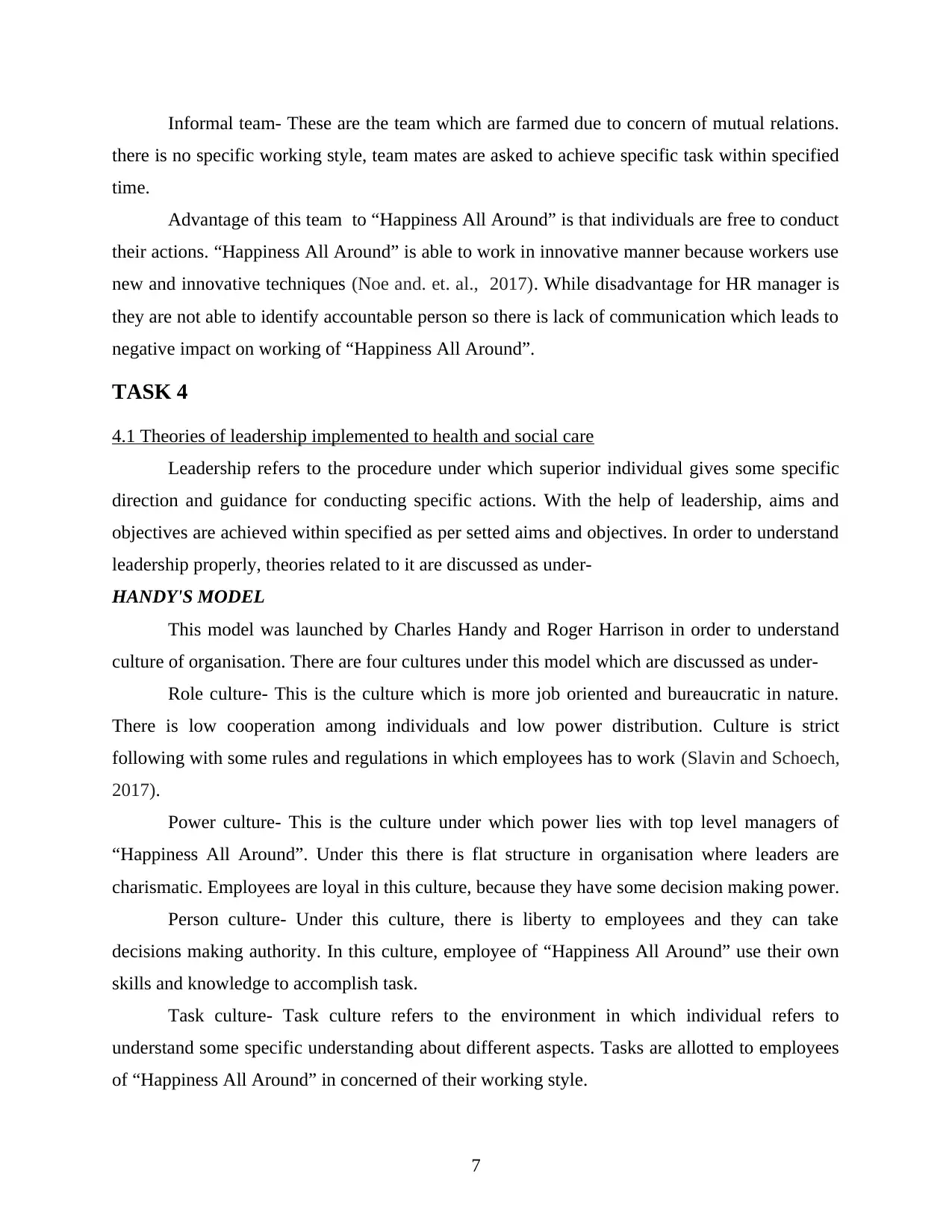
Informal team- These are the team which are farmed due to concern of mutual relations.
there is no specific working style, team mates are asked to achieve specific task within specified
time.
Advantage of this team to “Happiness All Around” is that individuals are free to conduct
their actions. “Happiness All Around” is able to work in innovative manner because workers use
new and innovative techniques (Noe and. et. al., 2017). While disadvantage for HR manager is
they are not able to identify accountable person so there is lack of communication which leads to
negative impact on working of “Happiness All Around”.
TASK 4
4.1 Theories of leadership implemented to health and social care
Leadership refers to the procedure under which superior individual gives some specific
direction and guidance for conducting specific actions. With the help of leadership, aims and
objectives are achieved within specified as per setted aims and objectives. In order to understand
leadership properly, theories related to it are discussed as under-
HANDY'S MODEL
This model was launched by Charles Handy and Roger Harrison in order to understand
culture of organisation. There are four cultures under this model which are discussed as under-
Role culture- This is the culture which is more job oriented and bureaucratic in nature.
There is low cooperation among individuals and low power distribution. Culture is strict
following with some rules and regulations in which employees has to work (Slavin and Schoech,
2017).
Power culture- This is the culture under which power lies with top level managers of
“Happiness All Around”. Under this there is flat structure in organisation where leaders are
charismatic. Employees are loyal in this culture, because they have some decision making power.
Person culture- Under this culture, there is liberty to employees and they can take
decisions making authority. In this culture, employee of “Happiness All Around” use their own
skills and knowledge to accomplish task.
Task culture- Task culture refers to the environment in which individual refers to
understand some specific understanding about different aspects. Tasks are allotted to employees
of “Happiness All Around” in concerned of their working style.
7
there is no specific working style, team mates are asked to achieve specific task within specified
time.
Advantage of this team to “Happiness All Around” is that individuals are free to conduct
their actions. “Happiness All Around” is able to work in innovative manner because workers use
new and innovative techniques (Noe and. et. al., 2017). While disadvantage for HR manager is
they are not able to identify accountable person so there is lack of communication which leads to
negative impact on working of “Happiness All Around”.
TASK 4
4.1 Theories of leadership implemented to health and social care
Leadership refers to the procedure under which superior individual gives some specific
direction and guidance for conducting specific actions. With the help of leadership, aims and
objectives are achieved within specified as per setted aims and objectives. In order to understand
leadership properly, theories related to it are discussed as under-
HANDY'S MODEL
This model was launched by Charles Handy and Roger Harrison in order to understand
culture of organisation. There are four cultures under this model which are discussed as under-
Role culture- This is the culture which is more job oriented and bureaucratic in nature.
There is low cooperation among individuals and low power distribution. Culture is strict
following with some rules and regulations in which employees has to work (Slavin and Schoech,
2017).
Power culture- This is the culture under which power lies with top level managers of
“Happiness All Around”. Under this there is flat structure in organisation where leaders are
charismatic. Employees are loyal in this culture, because they have some decision making power.
Person culture- Under this culture, there is liberty to employees and they can take
decisions making authority. In this culture, employee of “Happiness All Around” use their own
skills and knowledge to accomplish task.
Task culture- Task culture refers to the environment in which individual refers to
understand some specific understanding about different aspects. Tasks are allotted to employees
of “Happiness All Around” in concerned of their working style.
7
⊘ This is a preview!⊘
Do you want full access?
Subscribe today to unlock all pages.

Trusted by 1+ million students worldwide

GOLEMAN MODEL
There are different aspects which has to be considered by managers of “Happiness All
Around” providing knowledge about proper leadership to accomplish task in better and effective
manner. This model have five components which are self- awareness, self- regulation, internal
motivation, empathy and social skills. With considering this aspect there is requirement of some
specific qualities which are related to understanding changes in better and effective manner
(World Health Organization, 2016).
In order to improve working efficiency of “Happiness All Around”, there is requirement
of Handy's Model is best. In this model task culture is best because activities are assign to
employees as per their skills and working efficiency.
4.2 Analyse how working relationships can manage
“Happiness All Around” is the company which deals in health and social sector, there is
difference in demand of consumers. Working for old age people is crucial because they have
different issues and tantrums which has to mange by workers of “Happiness All Around”. So it is
essential to work and maintain relations with them. There are some ways such as proeper
communication, training, etc. through which working relationships can be managed and
maintained. Some are discussed as under-
Effective communication- There is requirement of proper communication among
workers, so they are able to know about their roles and responsibilities. When workers are aware
about their authority, then their efficiency gets improved because possibilities of improper
activities is nil (Smee, 2016). At “Happiness All Around”, there is requirement of proper
communication with which departments are aware about business actions and it is easy for them
to understand which department is dependant on their activities.
Constructive feedback- Feedback is the best way through which working relationships
can be managed. If there is negative feedback from some consumer then it must be considered
and it is essential to make corrective measures against it. There is requirement of collecting
proper feedbacks which are effective and relevant for taking corrective actions for betterment of
organisation. Consumer face some problem and if they share their issues with management of
“Happiness All Around” then actions has to be taken.
Emotional intelligence- Emotional intelligence is the way through which there is
capacity to become aware or to control one's emotion. This is the best way through which
8
There are different aspects which has to be considered by managers of “Happiness All
Around” providing knowledge about proper leadership to accomplish task in better and effective
manner. This model have five components which are self- awareness, self- regulation, internal
motivation, empathy and social skills. With considering this aspect there is requirement of some
specific qualities which are related to understanding changes in better and effective manner
(World Health Organization, 2016).
In order to improve working efficiency of “Happiness All Around”, there is requirement
of Handy's Model is best. In this model task culture is best because activities are assign to
employees as per their skills and working efficiency.
4.2 Analyse how working relationships can manage
“Happiness All Around” is the company which deals in health and social sector, there is
difference in demand of consumers. Working for old age people is crucial because they have
different issues and tantrums which has to mange by workers of “Happiness All Around”. So it is
essential to work and maintain relations with them. There are some ways such as proeper
communication, training, etc. through which working relationships can be managed and
maintained. Some are discussed as under-
Effective communication- There is requirement of proper communication among
workers, so they are able to know about their roles and responsibilities. When workers are aware
about their authority, then their efficiency gets improved because possibilities of improper
activities is nil (Smee, 2016). At “Happiness All Around”, there is requirement of proper
communication with which departments are aware about business actions and it is easy for them
to understand which department is dependant on their activities.
Constructive feedback- Feedback is the best way through which working relationships
can be managed. If there is negative feedback from some consumer then it must be considered
and it is essential to make corrective measures against it. There is requirement of collecting
proper feedbacks which are effective and relevant for taking corrective actions for betterment of
organisation. Consumer face some problem and if they share their issues with management of
“Happiness All Around” then actions has to be taken.
Emotional intelligence- Emotional intelligence is the way through which there is
capacity to become aware or to control one's emotion. This is the best way through which
8
Paraphrase This Document
Need a fresh take? Get an instant paraphrase of this document with our AI Paraphraser

interpersonal communication among workforce of “Happiness All Around” has to be considered.
These days, consumer wants to feel satisfied at place where they want to be satisfied. When
management started taking care of emotions of consumers, then it is easy for making long term
sustainability in industry.
4.3 Evaluation of own development influenced by management approaches considering own
experience
While working as HR assistant, I am able to learn different HR techniques and roles and
responsibilities which they have to understood. There are many employee within organisation, so
I prefer democratic management style best for improving working style of whole organisation.
As an individual I feel that democratic style is best because in this there is authority to
individuals as well to take part in decision making. Managers takes view point of “Happiness All
Around” and they have authority to understand what changes are required to be undertaken.
Under this theory I am able to improve my communication skills and my decision taking ability
gets improved. I am able to lead team by properly communicating with them considering
different aspects (Smith and Herman, 2016).
But there are some negative aspects as well. I am not able to analyse best training method
for individuals. I am weak in understanding mindset of workers. I am not able to make friendly
environment at team which makes formal boundations for workers. When some authority for
decision making is allotted to subordinates, then there are possibilities that they does not able to
compile information properly and understanding changes in proper manner because of difference
in mindset of personnel. Some times in organisation, I face personal conflict as well because
some individuals get mire opportunities because they perform well and some does not get it
because they are not preforming their roles and responsibilities properly.
TASK 3
Covered in PPT
CONCLUSION
From the above discussion, knowledge about different factors such as knowledge and
skills of individuals, cost of hiring, etc. has to be considered while planning for recruitment
process. Equal remuneration act, race discrimination act, etc. are considered for selection and
9
These days, consumer wants to feel satisfied at place where they want to be satisfied. When
management started taking care of emotions of consumers, then it is easy for making long term
sustainability in industry.
4.3 Evaluation of own development influenced by management approaches considering own
experience
While working as HR assistant, I am able to learn different HR techniques and roles and
responsibilities which they have to understood. There are many employee within organisation, so
I prefer democratic management style best for improving working style of whole organisation.
As an individual I feel that democratic style is best because in this there is authority to
individuals as well to take part in decision making. Managers takes view point of “Happiness All
Around” and they have authority to understand what changes are required to be undertaken.
Under this theory I am able to improve my communication skills and my decision taking ability
gets improved. I am able to lead team by properly communicating with them considering
different aspects (Smith and Herman, 2016).
But there are some negative aspects as well. I am not able to analyse best training method
for individuals. I am weak in understanding mindset of workers. I am not able to make friendly
environment at team which makes formal boundations for workers. When some authority for
decision making is allotted to subordinates, then there are possibilities that they does not able to
compile information properly and understanding changes in proper manner because of difference
in mindset of personnel. Some times in organisation, I face personal conflict as well because
some individuals get mire opportunities because they perform well and some does not get it
because they are not preforming their roles and responsibilities properly.
TASK 3
Covered in PPT
CONCLUSION
From the above discussion, knowledge about different factors such as knowledge and
skills of individuals, cost of hiring, etc. has to be considered while planning for recruitment
process. Equal remuneration act, race discrimination act, etc. are considered for selection and
9
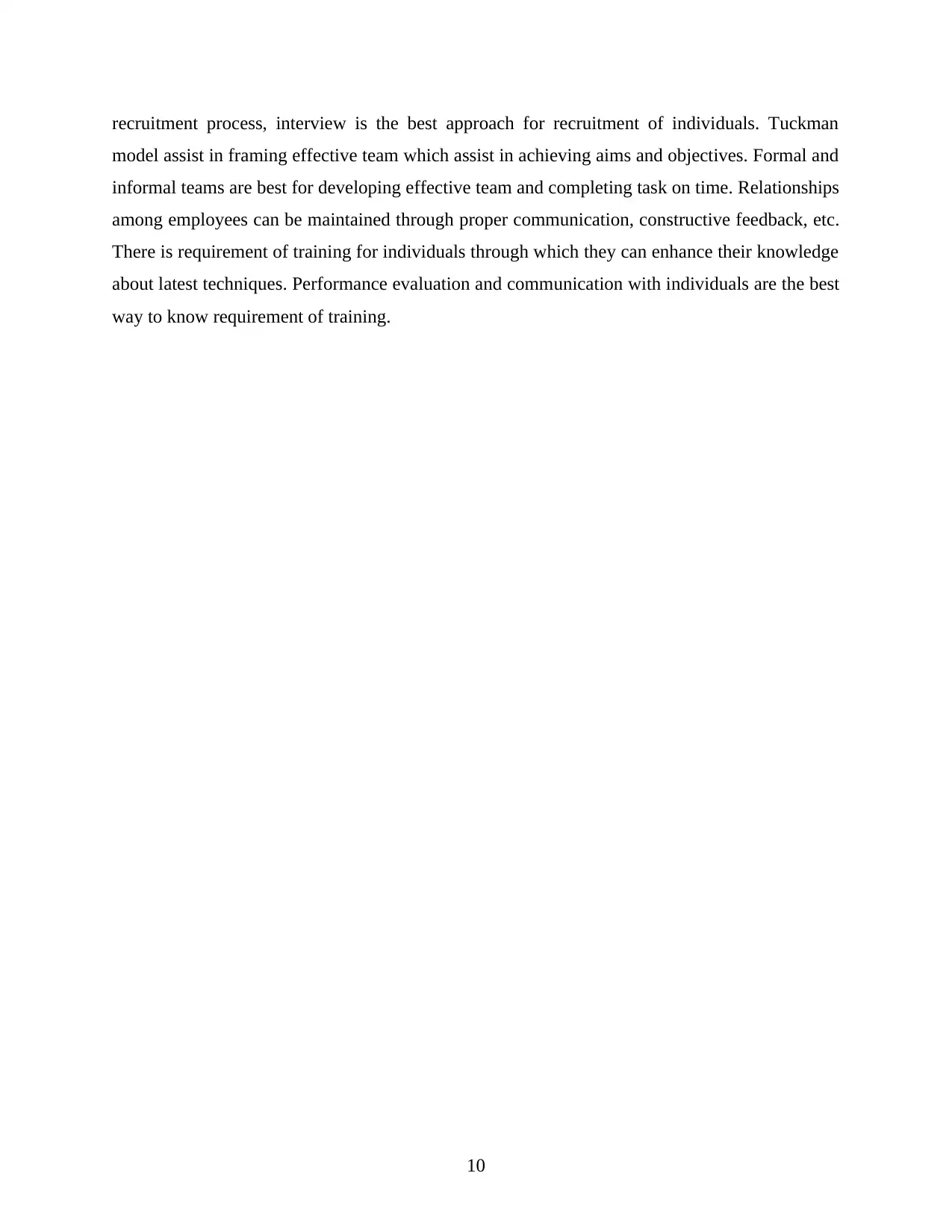
recruitment process, interview is the best approach for recruitment of individuals. Tuckman
model assist in framing effective team which assist in achieving aims and objectives. Formal and
informal teams are best for developing effective team and completing task on time. Relationships
among employees can be maintained through proper communication, constructive feedback, etc.
There is requirement of training for individuals through which they can enhance their knowledge
about latest techniques. Performance evaluation and communication with individuals are the best
way to know requirement of training.
10
model assist in framing effective team which assist in achieving aims and objectives. Formal and
informal teams are best for developing effective team and completing task on time. Relationships
among employees can be maintained through proper communication, constructive feedback, etc.
There is requirement of training for individuals through which they can enhance their knowledge
about latest techniques. Performance evaluation and communication with individuals are the best
way to know requirement of training.
10
⊘ This is a preview!⊘
Do you want full access?
Subscribe today to unlock all pages.

Trusted by 1+ million students worldwide
1 out of 13
Related Documents
Your All-in-One AI-Powered Toolkit for Academic Success.
+13062052269
info@desklib.com
Available 24*7 on WhatsApp / Email
![[object Object]](/_next/static/media/star-bottom.7253800d.svg)
Unlock your academic potential
Copyright © 2020–2025 A2Z Services. All Rights Reserved. Developed and managed by ZUCOL.





